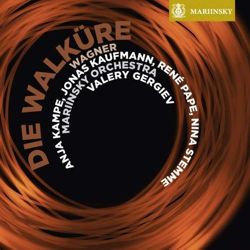|
|
|
|
|
|
|
|
|
The New York Times, May 3, 2013 |
| ANTHONY TOMMASINI |
|
|
|
Wagner: ‘Die Walküre’ |
|
| |
 Some
Wagner devotees have likened the “Ring” cycle to an epic, four-movement
operatic symphony, with “Die Walküre” as its great slow movement. I mean it
as high praise when I say that the work comes across this way in the
conductor Valery Gergiev’s recording with a superb cast and the Mariinsky
Orchestra. Not that the tempos are slower than usual, though some are. But
Mr. Gergiev conveys the depth, breadth and weightiness of this masterpiece. Some
Wagner devotees have likened the “Ring” cycle to an epic, four-movement
operatic symphony, with “Die Walküre” as its great slow movement. I mean it
as high praise when I say that the work comes across this way in the
conductor Valery Gergiev’s recording with a superb cast and the Mariinsky
Orchestra. Not that the tempos are slower than usual, though some are. But
Mr. Gergiev conveys the depth, breadth and weightiness of this masterpiece.
The opera has episodes of fiery drama and strokes of theatrical flair,
like the “Ride of the Valkyries.” But mostly we encounter godly characters
in uncertain states, grappling with a mysterious family drama.
In Act
I, drawing out dark orchestral sound and mellow string tone, Mr. Gergiev
uncovers the subdued yearning and bafflement between Sieglinde and Siegmund,
the twins separated in early childhood. He has ideal singers for the
roles: the magnificent tenor Jonas Kaufmann, an earnest, suffering yet
heroic Siegmund, and the gleaming soprano Anja Kampe, a poignantly
expressive Sieglinde.
When Hunding (Mikhail Petrenko), Sieglinde’s
bullying husband, returns home to find his wife with this young stranger,
the orchestra plays Hunding’s well-known motif: a gruff, imposing fanfare.
But in the subdued, calculating way Mr. Gergiev conducts it, the motif seems
not a signal to listeners of Hunding’s arrival but a reflection of the
character’s thoughts, as the suspicious Hunding wonders what is going on.
The entire performance is filled with similarly fresh interpretive choices.
The soprano Nina Stemme, the reigning Brünnhilde of the day, sings with
lustrous sound and exciting intensity. The great bass René Pape, in
commanding voice, is an impulsive and, by the end, chastened Wotan.
Ekaterina Gubanova is an earthy Fricka. And for once, the “Ride of the
Valkyries” sounds like a stirring ride, not a frantic race.
|
|
|
|
|
|
|
|
|
|
|
|
|
|
|
|
|
|
|